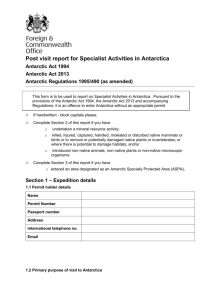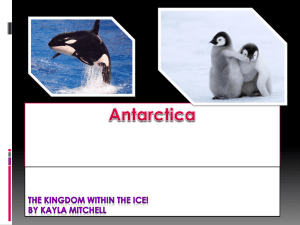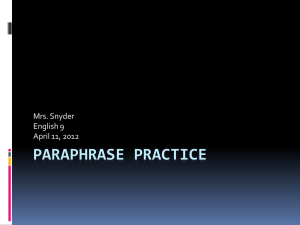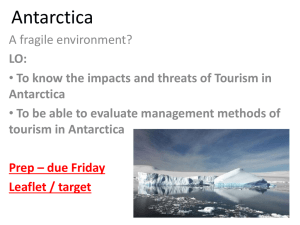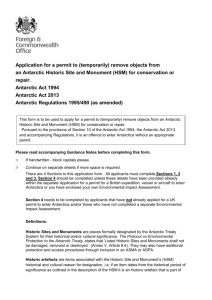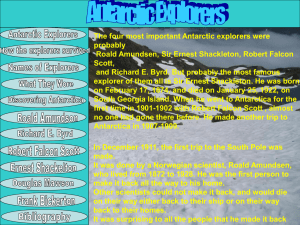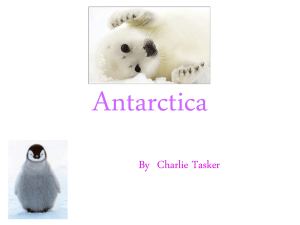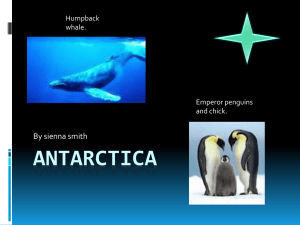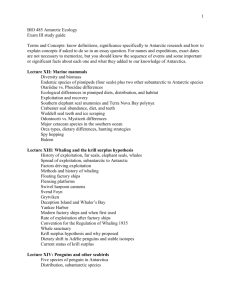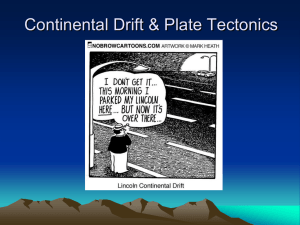UNCL 130515 Section 6 Combined Scientific research
advertisement
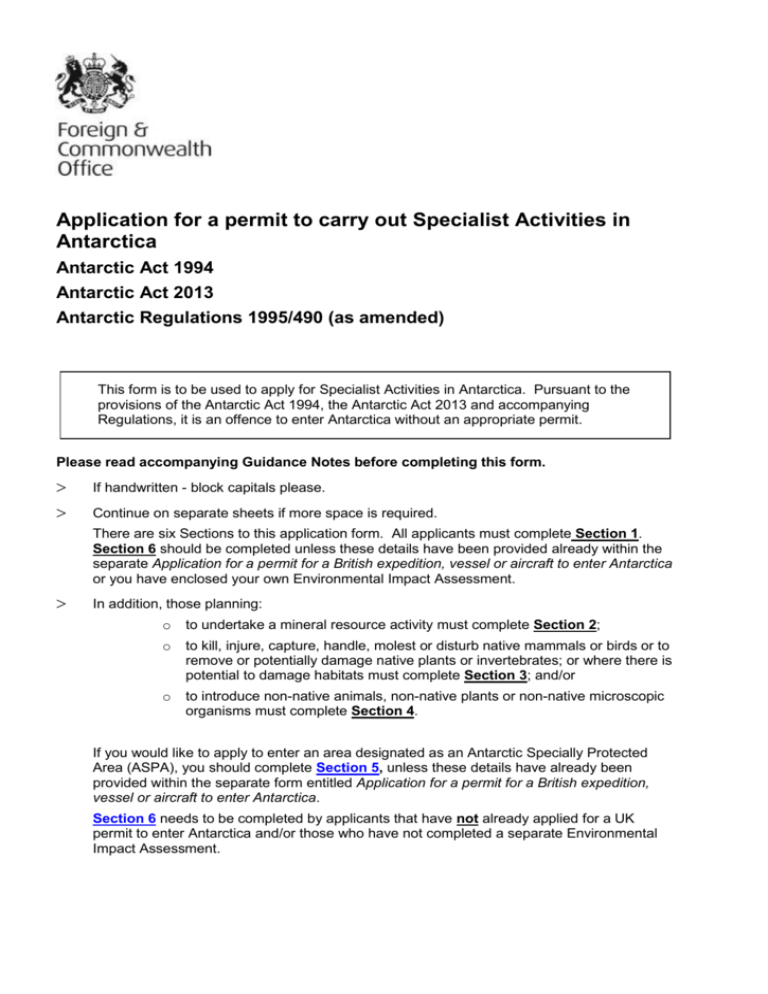
Application for a permit to carry out Specialist Activities in Antarctica Antarctic Act 1994 Antarctic Act 2013 Antarctic Regulations 1995/490 (as amended) This form is to be used to apply for Specialist Activities in Antarctica. Pursuant to the provisions of the Antarctic Act 1994, the Antarctic Act 2013 and accompanying Regulations, it is an offence to enter Antarctica without an appropriate permit. Please read accompanying Guidance Notes before completing this form. If handwritten - block capitals please. Continue on separate sheets if more space is required. There are six Sections to this application form. All applicants must complete Section 1. Section 6 should be completed unless these details have been provided already within the separate Application for a permit for a British expedition, vessel or aircraft to enter Antarctica or you have enclosed your own Environmental Impact Assessment. In addition, those planning: o to undertake a mineral resource activity must complete Section 2; o to kill, injure, capture, handle, molest or disturb native mammals or birds or to remove or potentially damage native plants or invertebrates; or where there is potential to damage habitats must complete Section 3; and/or o to introduce non-native animals, non-native plants or non-native microscopic organisms must complete Section 4. If you would like to apply to enter an area designated as an Antarctic Specially Protected Area (ASPA), you should complete Section 5, unless these details have already been provided within the separate form entitled Application for a permit for a British expedition, vessel or aircraft to enter Antarctica. Section 6 needs to be completed by applicants that have not already applied for a UK permit to enter Antarctica and/or those who have not completed a separate Environmental Impact Assessment. Section 1 – Application details 1.1 Applicant details Full Name as per passport Full Postal Address International Telephone No. E-mail Organisation (if applicable) Nationality Passport Number A scanned copy of the photograph page of the passport of the applicant (who will become the permit holder if the application is successful) must be submitted with this application. 1.2 Arrival and departure dates Place of final departure for Antarctica Date of initial entry into Antarctica (60 South latitude) Date of final exit from Antarctica (60 South latitude) First place of call after final exit from Antarctica Period for which the permit is required From: To: 1.3 In addition to this Specialist Activities application form, have you applied or do you plan to apply for a UK permit to enter Antarctica? If yes, please provide the applicant’s details if different from those provided in Question 1.1. If no, please confirm under what authorisation you intend to enter Antarctica. (e.g. via authorisation granted by another Antarctic Treaty Party or through a permit obtained by the British Antarctic Survey (BAS) or another British institute) 1.4 Where will the proposed activity take place? 1.5 Does the expedition intend to visit any Antarctic Specially Protected Areas E.g. Rothera Point, Antarctic Peninsula (ASPA), Antarctic Specially Managed Areas (ASMA), wildlife sites or other protected areas? If yes, please provide details. 2 1.5 If you intend to visit an ASPA site you will need to also complete Section 5. If you have already filled in an application for a UK permit to enter Antarctica, you do not need to complete section 5, but please provide brief details such as ASPA number below. A list of ASPAs can be found in the schedules to the Antarctic Regulations 1995, as amended by Antarctic Amendment Regulations 2000/2147, 2002/2054, 2003/323, 2004/2782 and 2009/2354 and at http://www.ats.aq/documents/ATCM35/WW/atcm35_ww004_e.pdf 1.6 Other people who should be covered by this permit*. A full and final list (including their nationalities and passport numbers) must be submitted before departure; we are aware they may not be known at the time of application. Full name (as per their passport) e.g. John Alan Smith Nationality British Passport no. 123456789 Previous experience of scientific research in the Arctic, Antarctica or in other cold or high altitude areas? (Y/N) Y If ‘yes’ for previous column, please provide details e.g. Science project with BAS on counting penguins, ice drilling, etc. *Where these names change prior to entry to Antarctica, please ensure that you inform the Polar Regions Department at the FCO and provide full details. 4 1.7 Means of transportation within Antarctica: Ski/man haul Skidoo Vessel Aircraft Other, please provide details: 1.8 Has an Environmental Impact Assessment been undertaken? If ‘Yes’, please include a copy of the Assessment with your application and summarise the conclusions here. If ‘No’, you will need to complete Section 6. 1.9 Please identify which of the following specialist activities you plan to undertake in Antarctica: Mineral resource activity pursuant to section 6 of the Antarctic Act 1994 Disturbance of flora, fauna and/or potential damage to habitat Pursuant to Section 7 of the Antarctic Act 1994 Other – please specify: Introduction of non-native animals, plants and microorganisms pursuant to Section 8 of the Antarctic Act 1994 Section 2 –Permit to undertake mineral resource activity* for the purposes of scientific research 2.1 Please provide a brief outline of the scientific purpose of the proposed activities: 2.2 Please give a description of what mineral resource activities you wish to undertake and why the activities are essential for your research: 2.3 Are the mineral resources being sought available, in an appropriate form, from publicly accessible collections outside of the Antarctic Treaty area? E.g. Rock/fossil collections in museums 2.4 If not, in what way do the required samples differ from those which are available already? E.g. from a different area of Antarctica 2.5 What transport, storage and curation arrangements will be made for the mineral resources once they have been removed from Antarctica? E.g. stored at the Natural History Museum in x collection for x years (or permanently) for future research * Mineral Resources includes, but not exclusively, peat, soil, lake & marine sediment, sea bed nodules, rocks, fossil, coal etc. Mineral resource activities include: drilling; dredging; excavation; and collection 6 Section 3 – Permit to kill, injure, capture, handle, molest or disturb native mammals or native birds; to remove or damage native plants or invertebrates; or to cause potential damage to habitats for the purposes of scientific research, 3.1. Please provide a brief outline of the scientific purpose of the proposed activities: 3.2 Please indicate what activities you intend to undertake which may or will result in the killing, injuring, capturing, handling, molesting, disturbing, removing or damaging to species or potential to damage habitat: 3.3 Where native mammals, birds or invertebrates are involved in research, how will you ensure that they will be treated in an appropriately humane manner? If the project has been subject to an ethical review, please include details of (i) the reviewing body, (ii) the date the review was undertaken and (iii) the conclusions and any project-specific recommendations. 3.4 If the mammals, birds or invertebrates (alive or deceased) are to be transported, how will this be done? 3.5 If you wish to do something which would cause potential damage to the habitat of any native mammal, bird, plant or invertebrate. Please give full details of the activity and the habitat: 3.6 Please give the species of native mammal, bird, invertebrate or native plant which would be affected by the activity: Species (common name) Species scientific (Latin) name Quantity (number and total weight) Age/life stage** Sex e.g. eggs, chick, juvenile, breeding adult 3.7 Do you intend to carry out activities which could be considered as ‘biological prospecting’? (For example, collecting genetic material from Antarctic, flora and/or fauna for the purpose of extracting future potential economic value, or where collection might lead to commercial applications) If so, please quantify and describe the samples involved, the collection and storage methods and any further details in relation to the use of the samples: 8 Section 4 – Permit to allow the introduction of non-native* animals, plants or microscopic organisms for the purposes of scientific research ”non-native” species are those that are not indigenous to the Antarctic Treaty area during any stage of their lifecycle, or which do not occur there seasonally through natural migrations 4.1 Please provide a brief outline of the scientific purpose for the proposed introduction 4.2 Where will the introduced non-native species be kept in Antarctica? 4.3 Please outline the precautions that will be taken to prevent escape or spread of the introduced species or their contact with native fauna, flora and the Antarctic environment: 4.4 Please outline the methods of removal of introduced species or their disposal by incineration, sterilisation or other means, and describe how the wastes will be disposed of: 4.5 Please indicate below which species of non-native animal(s) and/or plant(s) and/or microscopic organism(s) are to be introduced: Species (common name) Species scientific (Latin) name Quantity Age/life stage** Sex e.g. eggs, chick, juvenile, breeding adult 4.6 Please set your risk assessment of the introduction each non-native species, including potential consequences of accidental release: Section 5 – ASPA sites This section only needs to be completed by those intending to visit an ASPA and who have not already supplied these details in the separate form entitled Application for a British expedition, vessel or aircraft to enter Antarctica 5.1 Please provide below details of any ASPA you intend to visit. Details of the location of the ASPA sites can be found at http://www.ats.aq/documents/ATCM35/WW/atcm35_ww004_e.pdf Name and location and coordinates of Reason for entry to protected area (please Proposed date of Proposed date of exit ASPA include details of the activities planned, and entry into ASPA site from ASPA site scientific purpose (if not already covered elsewhere in this form) 10 5.2 Why do these scientific activities need to take place in the specified ASPA(s) site(s)? 5.3 What steps will you take to ensure you follow the Management Plan for the ASPA site? 5.4 How does the expedition intend to travel to and return from the ASPA? 5.5 If you are planning to camp in an ASPA please indicate which ASPA(s) and how for long: Section 6 – Environmental Impact: Preliminary Environmental Assessment. You should complete this section unless these details have already been provided within the separate Application for a permit for a British expedition, vessel or aircraft to enter Antarctica or you have enclosed your own Environmental Impact Assessment. 6.1 If you intend to visit site designated as Antarctic Specially Managed Areas (ASMA), Historic Site and Monuments (HSMs) or visitor sites with Site Guidelines for Visitors, please state how you will ensure that all members of the expedition will abide by the Management Plans and guidance that apply to those locations. (See: http://www.ats.aq/documents/recatt/Att004_e.pdf ) 6.3 Will any of the activities involve visits to sites which you believe may have not been visited before? If so, where? 6.4 Will any hazardous substances be taken into Antarctica? Please list any hazardous substances (e.g. chemical substances), radioactive material or stable isotopes that you propose to use. For each substance, please list (i) the hazard class, (ii) the quantity, (iii) why it is required and (iv) whether or not they will be released into the environment. Please explain how they are intended to be used. 12 6.5. Do you intend to install any equipment in Antarctica (e.g. data loggers or markers)? If yes, please provide (i) a brief description of the equipment, (ii) a summary of the installation location, (iii) detail of how the equipment will be maintained and (iv) when it will be removed. 6.6. Do you intend to store fuel, outside the main tanks of a vessel or within the Antarctic terrestrial environment? For each fuel type please state the quantity and location of the storage facility. If a fuel transfer is to be undertaken, please state the quantity and location of the storage facility. If a fuel transfer is to be undertaken, please provide details including a copy of the fuel Spill Contingency Plan. 6.7. Please provide details of waste disposal procedures proposed for the expedition: Sewage Quantity expected to be generated Packaging and Disposal practices Grey water Quantity expected to be generated Packaging and Disposal practices Food waste (other than meat and poultry product waste) Quantity expected to be generated Packaging and Disposal practices Meat and poultry product waste Quantity expected to be generated Packaging and Disposal practices General waste Quantity expected to be generated Packaging and Disposal practices 6.8 Where will wastes removed from Antarctica be disposed of? 6.9. Please describe how the Permit holder will ensure compliance with current Antarctic environmental legislation (including the Protocol on Environmental Protection to the Antarctic Treaty) 14 6.10. How will the Permit holder ensure the expedition members covered by this Permit will be fully informed of all their environmental responsibilities? (Including, but not limited to disturbance of wildlife, introduction of non-native species, waste disposal, respecting historic sites and minimising trampling impacts). 6.11 Environmental Impact Matrix Please complete the matrix located on the following page for each activity you intend to undertake. List all activities involved. This should include any science activities as well as logistical activities such as the storage and handling of fuels and chemicals, waste management and camping activities. Consider the likely impact of your actions on flora and or fauna and the marine and terrestrial environment. You should also consider cumulative impacts on the environmental, historic, aesthetic, wilderness and scientific value of the site. Effects on the value of the area for future visitors should also be considered. Provide details of the mitigation which will be undertaken to ensure that negative impacts are minimised or avoided. Please note that you can either extend the amount of rows within the matrix or submit your own version of an environmental impact matrix, if the space provided is inadequate for the entirety of your activities. Environmental Impact Matrix Activity Duration and intensity of activity Possible impact Mitigating measures 16 Checklist – please ensure you have included with your application: A copy of the photograph page of the applicant’s passport Where appropriate, a copy of your own Environmental Impact Assessment (Q1.8) Signature In accordance with Regulation 2 of The Antarctic (Amendment) Regulations 2008/3066, brief details of all permit applications will be published on the FCO website. Your signature below will be taken as consent to publish the necessary information. Please provide below the details for publication. Signature of applicant Date Official position (if applicable) Summary of purpose of application to appear on the FCO website Eg application undertake biological samples of gentoo penguins at x This application form should be returned to: Polar Regions Department Overseas Territories Directorate Foreign and Commonwealth Office King Charles Street London SW1A 2AH polarregions@fco.gov.uk
